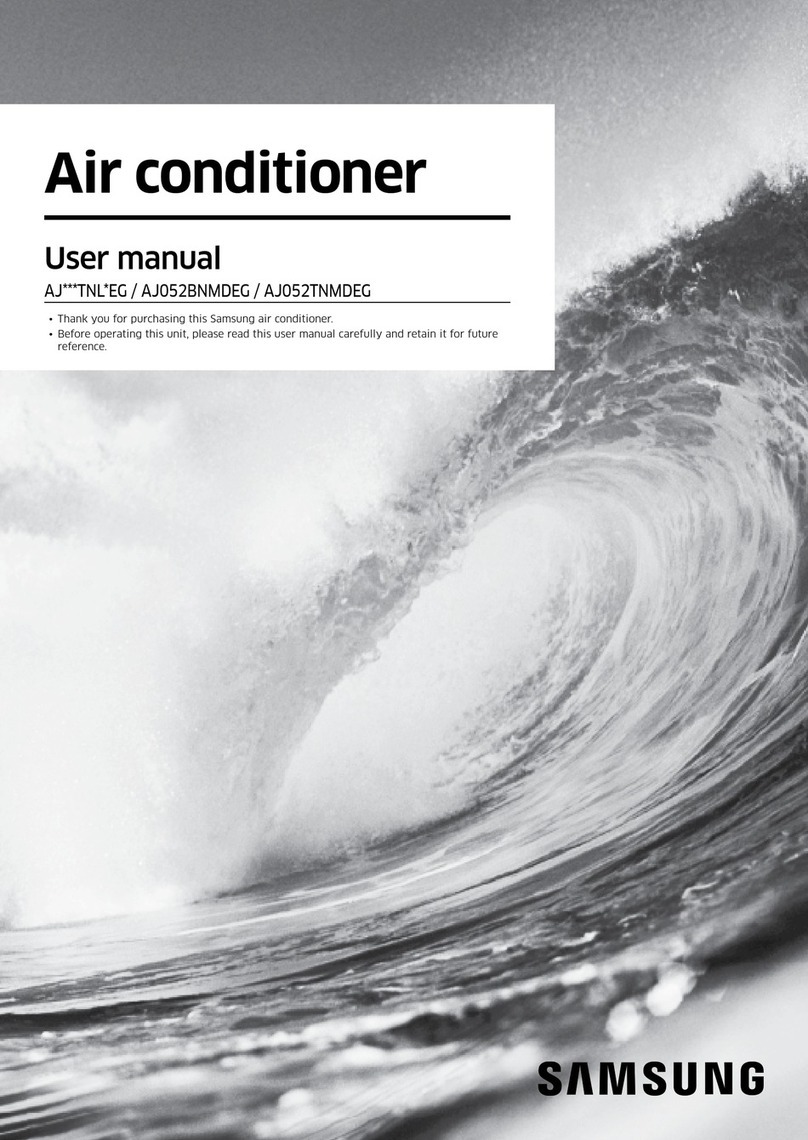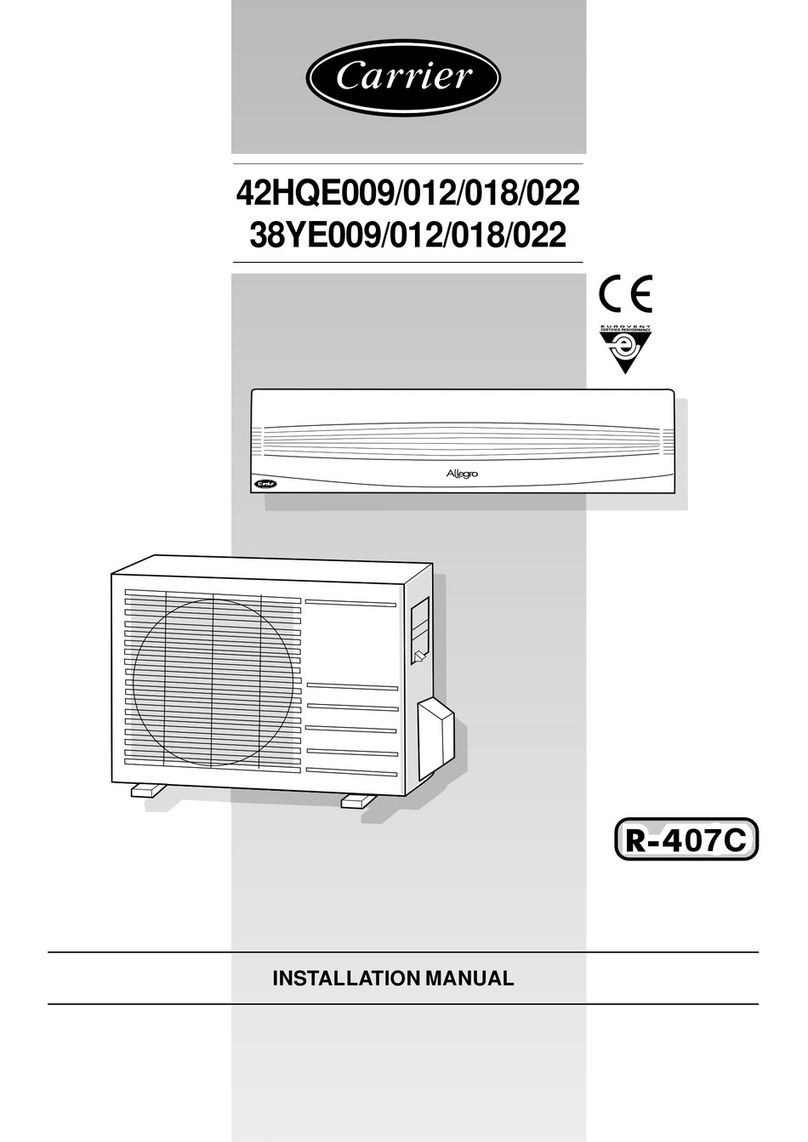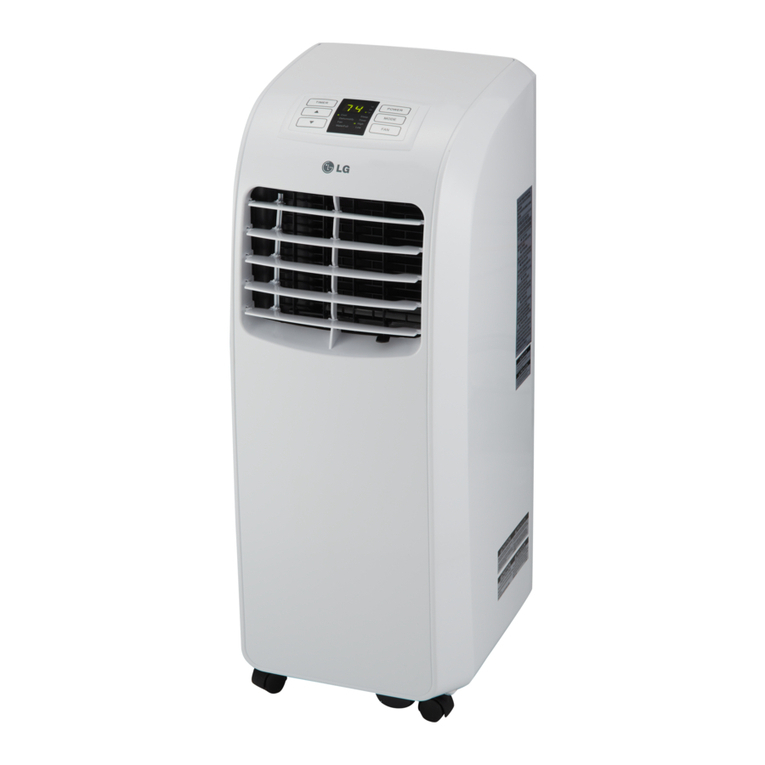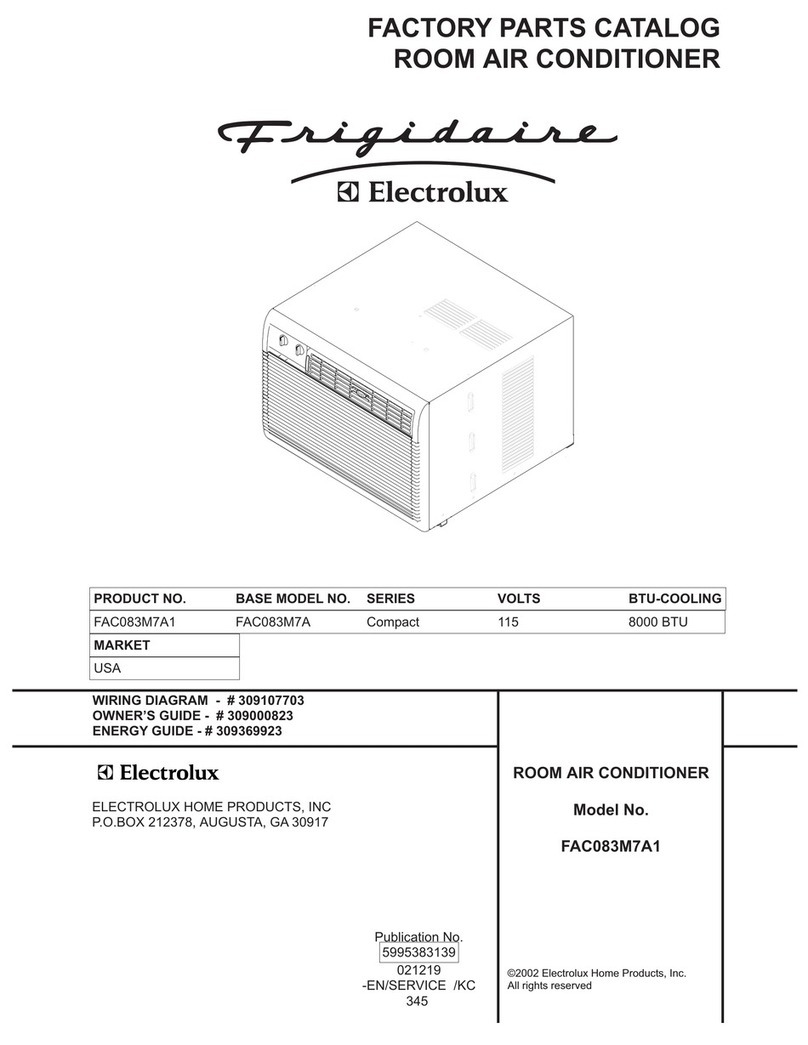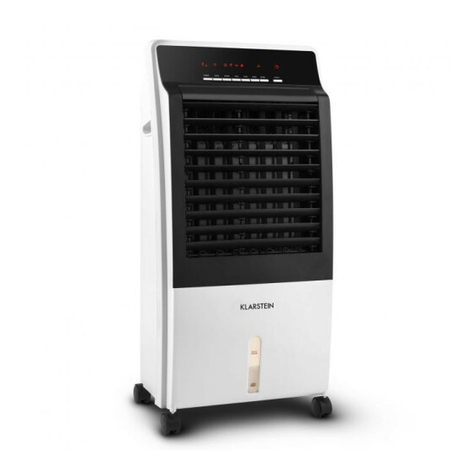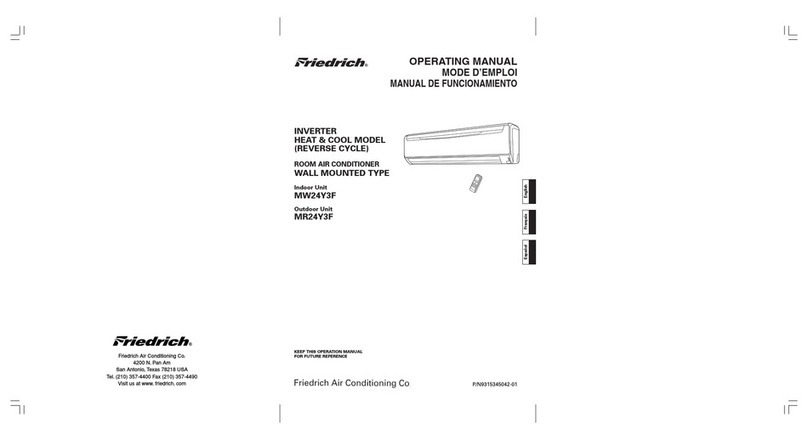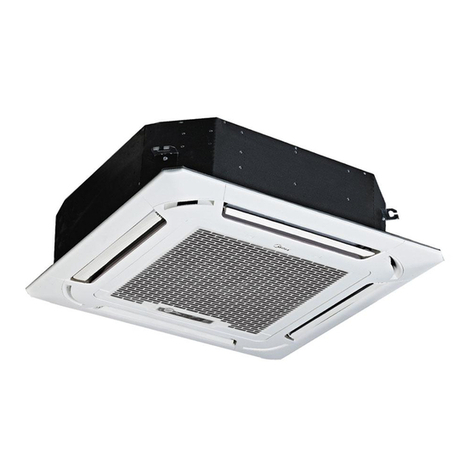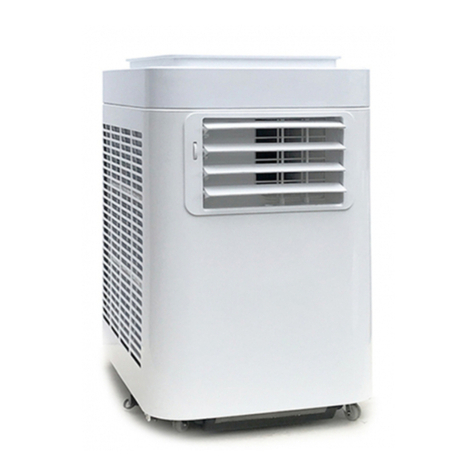Robur AD 14 User manual

Installation, use and
Maintenance manual
Evaporative Cooler AD 14
Evaporative cooling is a completely natural way
of producing refreshing cool air
for warehouses or factories

Installation, use and Maintenance manual - ed. 04/14 2
EDITION: 04/2014
Code: D-LBR483
This manual has been drawn up and printed by Robur S.p.A.; whole or partial
reproduction of this manual is prohibited.
The original is filed at Robur S.p.A.
Any use of this manual other than for personal consultation must be previously authorised
by Robur S.p.A.
The rights of those who have legitimately filed the registered trademarks contained within
this publication are not affected
With the aim of continuously improving the quality of our products, Robur S.p.A. reserves
the right to vary the data and contents of this manual without prior notice.

3 Installation, use and Maintenance manual - ed. 04/14
FOREWORD
This manual is for anyone who must install or use the Robur AD 14 evaporative cooler.
This manual especially applies to the plumbers who must install the evaporative cooler,
to the electrician who must connect the heating unit to the electrical system and to the
end user who must check that it functions properly.
This manual is also for the technicians regarding the principle maintenance operations.
CONTENTS
1 – General Information ………………………………………………………….. 4
2 – Installation …………………………………………………………. 7
3– Control system …………………………………………………………. 14
4 – Commissioning ……………………………………………………….... 20
5 – Operating of the unit and Settings ………………………………… 23
6 – Maintenance and Service …………………………………………………. 28
Evaporative Cooling Operating Instruction …………………………………. 34

Installation, use and Maintenance manual - ed. 04/14 4
SECTION 1 GENERAL INFORMATION
In this section you will find the general instructions to follow for the installation and use of
the AD 14 evaporative cooler, a brief mention of the operation of the unit, the constructive
characteristics and the technical data.
1.1 GENERAL WARNING
This manual is an integral and essential part of the product and must be given to the user.
This unit must be exclusively used for the purpose it was intended. Any other use is to be
considered improper and therefore dangerous.
This unit must be exclusively used for the purpose it was intended. Any other use is to be
considered improper and therefore dangerous.
The manufacturer will not be held responsible for damages resulting from installation
errors or failure to comply with the manufacturer’s instructions.
The unit must be installed in accordance with local regulations.
)
In case of failure and/or poor operation, isolate the unit (disconnect it from the
power supply and close water supply valve), do not attempt any repair or direct servicing.
Call qualified service engineers only.
The manufacturer’s authorised service centres using only original spare parts must only
carry out any repair to the products.
Misapplication of the above might compromise the safety of the unit.
To ensure unit efficiency and correct operation, it is essential that qualified service
engineers carry out annual maintenance following the manufacturer’s instructions.
Should the unit be sold or transferred to another owner, please ensure that the manual
remains with the unit for use by the new owner and/or installer.
Before turning the heater on, a qualified service engineer must check:
- that the electric ratings are the same as those on the data plate.
- that water supply pressure are the same as those on the data plate..
If the cooler is turned off for prolonged periods of time, close the water supply valve and
cut off the electrical supply.

5 Installation, use and Maintenance manual - ed. 04/14
1.2 OPERATION OF THE UNIT
Evaporative cooling is a completely natural way of producing refreshing cool air that have
been specifically designed for the cooling of industrial and commercial building.
It is designed for outdoor installation with down, top and side discharge and also as
internal suspended cooler.
Cooling is provide by Evaporative heat exchange which take advantage of the principles of
the latent heat of evaporation where tremendous heat is exchanged when water
evaporates. It makes use of the free latent energy in the atmosphere.
Water is brought into the cooler from the mains water supplì and is pumped up to the top
of the unit using circulation pump. The water is then dispersed over the Celdek pads using
a water distribution system which allows the water to flow continually over the pad.
The pads become satured, air is drawn through the pads and the water evaporate causing
the air to cool. The cool air is then ducted round the building to provide cooling by means
of an axial fan.
The control system comprises of a main control panel which controls all components by
communicating with a wall mounted control box and a set of external inputs (like
thermostat, humidistat, timer, alarm, etc)
1.3 CONSTRUCTIVE CHARACTERISTICS
Evaporative Cooler AD 14 is supplied with:
- The cooling pads are cellulosa based 680x850x100 mm thickness
- Axial fan 1 to 5 speeds and high static pressure
- Control board with microprocessor is the heart of control system and
connected to a unique level probe system empties completely the sump whenever
the system goes out of cooling mode, so that no stagnant water remains in the
system and when the water approaches the scale index. It is supplied with 30m
cable
- Circulation pump is pumping the water from the sump over the pads via a water
distribution system. 50W, 30 l/min
- 4 water level probes to check water level into the sump. They also check
through electronic board the quantity and quality of the water.
- Water supply valve and drain valve controlled by electronic board
- Wall mounted control box could be connected to thermostat to give automatic
control. Facility to connect to timer, humidistat and fire alarm contact.
- Water sump and side panels are injection moulded structural from
polypropylene. The cabinet is UV stabilized and corrosion free.

Installation, use and Maintenance manual - ed. 04/14 6
1.4 TECHNICAL DATA
Air Flow Rate m3/h 14.000
Water Supply Pressure min/max bar 1 / 7
Minimum Water Flow Rate l/min 8
Water Sump Capacity l 23
Electrical Supply 230 V – 50 Hz
Water Supply Connection “ ½
Water Drain Connection “ 1
Square Duct Dimensions mm 645 x 645
Axial Fan Rating kW 1,5
Water Pump Rating kW 0,05
Noise Level @ 3 meter max speed
min speed
dB(A)
dB(A)
74
64
Dimensions : Width
Depth
Height
mm
mm
mm
1.170
1.170
950
Weight: dry kg 92
Weight: operating kg 127
Weight: transport kg 117

7 Installation, use and Maintenance manual - ed. 04/14
SECTION 2 INSTALLATION
This installation section describes the installation of the cooler with standard controls. If other
control such as a thermostat or humidistat is to be used the 5 speed control panel instructions must
be consulted
2.1 - Delivery
The unit is delivered mounted on a pallet
which is used to support the unit during
installation. A protective cardboard cover is,
together with internal polystyrene pads,
banded to the pallet.
This is a fragile item and must be handled
carefully. The maximum stacking height is 2.
Once removed from the pallet take great care
not to damage the drain which protruded from
the bottom of the unit.
2.2 - Installation
The dimensions of the unit are shown in the
diagram opposite.
A minimum of 300mm clearance must be
provided around the unit to enable the side
panels to be removed.
The operating weight of the unit, when full of
water is 92Kg
AD 14 is designed to be supported from a
plain square duct with nominal external
dimensions 645mm x 645mm.
Note that due to the variation in the
moulding of plastics there may be
some variation in these dimensions –
the final duct must be manufactured to
fit the cooler.

Installation, use and Maintenance manual - ed. 04/14 8
The side frames are also act as a guard
for the fan. Set screws prevent their
removal unless a tool is used to comply
with guarding regulations.
To remove the side panel first remove the security screws. Then lift the panel and the top
edge can be removed.
To replace the panel reverse the above.
There are location points for the cooler to
sit on the duct. When the cooler sits on a
level duct these points ensure the cooler
is level.
The cooler must be installed on a level to
ensure safe and efficient operations. The
duct enters the cooler 30mm.
A typical roof mounted installation to a
plenum chamber is shown. Checks must
be made that the roof structure can
support the full operating weight of the
system plus the ductwork and plenum
chamber.
Coolers should not be placed where the
intake could be contaminated with fumes,
heavy dust etc.
On a sloping roof the cooler is normally
installed with the drain at the lowest point.
The cooler must be mounted sufficiently
high so that the drain connection can be
made – typically 150mm clear from the
roof on the upper side
Drain Water

9 Installation, use and Maintenance manual - ed. 04/14
The cooler is then fixed to the ductwork
using fixings appropriate for the duct
material. It is recommended than a
minimum of 3 fixings are made on each
side.
Appropriate weather proofing should be
made according to the roof structure and
local weather conditions.
It is normal to support the weight of th
e
cooler on supports on the underside of th
e
roof.
2.3 - Support brackets installation
Every Evaporative Cooler AD 14 is standard
delivered with no. 2 adjustable support
brackets.
The purpose of the brackets is to support
the heaviest side of the cooler, where the
internal water tank is positioned, in case
the AD14 Cooler is installed directly on the
air duct system (standard down discharge)
– see picture below.
With this kind of installation, and in particularly hot climate conditions (if the cooler is
exposed directly to the sun for many hours), it is better that the heaviest side of the
tank (where the water is deepest), is fixed with these brackets, so that the plastic part
of the water tank get more stability.
NOTE
These support brackets must be used only if the cooler is NOT standing on the 4
points of support.

Installation, use and Maintenance manual - ed. 04/14 10
To install the brackets, please proceed like follows:
-install the cooler, connecting the cool air down discharge to the duct system
below
-fix the brackets to the duct as shown in the diagram below
-adjust the brackets so that the water tank is levelled and well-supported by the
brackets
2.4 – Services connections
The services are all fed from the bottom at the points shown

11 Installation, use and Maintenance manual - ed. 04/14
2.5 – Electrical supply
The electrical connections must be done by Qualified service engineering. Before
beginning this operation, cut off the electrical supply.
1. Check that the voltage supply is 240/50Hz single-phase
2. Carry out the electrical connections accordino to the installation wiring diagram
3. When connecting, censure that the earth wire is longer than the live wires, so that i
twill be the last wire to break if the supply cable is stretched, thus ensuring a good
earth continuità.
)The electrical safety of the unit attained only when the unit itself is correctly
connected and efficiently grounded according to the exhisting safety standards.
4. The unit should be connected to the electric supply line by means of an omnipolar
switch with a minimum contact opening of 3 mm. An omnipolar switch ia a “Double
pole isolating switch”, i.e. a switch capable of disconnecting both on phase and
neutral. This means that when the switch is opened, both contacts are disconnected.
2.6 - Water
The cooler must be supplied with fresh,
mains water to maintain hygienic and
efficient operation. It is connected to the
underside of the cooler using a 1/2” bsp
connection. The water pressure must a
minimum of 1 bar and a maximum of 7 bar
with a total flow rate of 500l/hr.
It is recommended that a ‘double check’
valve is fitted. All water installations
should conform to local regulations.
A flexible connection pipe is provided.
It is recommended that this used to
prevent stress on the water solenoid valve
fitting

Installation, use and Maintenance manual - ed. 04/14 12
2.7 - Drain
The drain outlet is a 1”bsp
fitting. The drain capacity must exceed
2000 l/hr to an appropriate disposal point
which conforms to local water regulations.
The drain valve, on delivery, requires
fitting to the base of the sump. A 1” bsp
nut and gasket is supplied which are used
to fix to the sump.
To avoid damage to the water and drain valves during the winter months of non-use
of the AD 14 it is necessary to discharge the hydraulic circuit (including water supply
pipe).
2.8 – Remote Control
The wall mounted controller comes fitted with a 30m control cable. This can be extended
up to 200m using appropriate standard 16 core 0.75mm2.
The control voltages contained within these controllers are +/-12V.
The wiring diagram for the controller is shown below. The Automatic mode will be
discussed in detail later.
The control cable is 16 cores. It is connected to the wall control box by two terminal
blocks.

13 Installation, use and Maintenance manual - ed. 04/14
The first terminal block is used for all of the manual controls (plus the purple automatic
cable).
The second terminal block is for the Alarm, Timer, Humidistat and Thermostat.
Note that the Alarm and Timer contacts must be made for the cooler to operate.

Installation, use and Maintenance manual - ed. 04/14 14
SECTION 3 CONTROL SYSTEM
3.1 Overview of system
The control system comprises of a main control panel which controls the above
components by communicating with a wall mounted control box and a set of external
inputs.
The purpose of the control system in evaporative coolers is to control the following
functions which are accessible by the operator
•Power - ON/OFF
oTurns the cooler on - starts the fan and operates in cool or vent as selected
oTurns the cooler off – stops all functions and cooler drains automatically
•Auto - Man/Auto
oIn manual mode the cooler follows the set fan speed and cool/vent mode
oIn Auto the fan speed and cool/vent mode are automatically set according to
the status of the thermostat and humidistat.
•Fan Speeds 1 to 5
oManual setting of fan speed
•Cooling - Cool or Vent mode
oVent mode
Water circuit is disabled
Sump drains automatically
oCool mode
Water circuit is enabled
•Fill cycle enabled
•Bleed control enabled
Allarme antincendio
Velocità 4
Velocità 5
Cool/Vent
Man/Auto
Velocità 3
Velocità 2
Velocità 1
On/Off
On/Off
Igrostato interno
On/Off
Igrostato esterno
On/Off
Timer
On/Off
Termostato
On/Off
Remote
control
Allarme

15 Installation, use and Maintenance manual - ed. 04/14
oAlarm
Highlights the system has an error
The number of pulses indicates the fault present.
The purpose of the system is to control the following components
V1 Water inlet valve – controls the water into the cooler
V2 Drain valve – controls the drain from the cooler
L1 Level Probe – controls the water levels in the cooler
L2 Level Probe – controls the water levels in the cooler
L3 Level Probe – controls the water levels in the cooler
L4 Level Probe – controls the water levels in the cooler
P1 Circulation Pump – circulates the water onto the cooling media
F1 Fan – double wound single phase fan motor
Water in
L1 L2 L3 L4
P1
V1
F1
V2
Water out

Installation, use and Maintenance manual - ed. 04/14 16
3.2- The Control Board- The Controller
The heart of control system is a printed circuit board. The layout with the key input/output
locations is shown below
3.3 Detailed Description of Input and Outputs
3.3.1 - LED Display
On power-up this displays the salinity setting for 3 seconds. During normal running this
shows a single red dot at the lower right hand corner unless an alarm has occurred and
this is retained. In an alarm condition it shows the following codes
01 – Slow fill Auto Reset
02 – Overflow Manual Reset
03 – Probes out of sequence Manual Reset
04 – Abnormal evaporation Manual Reset
05 – Slow Drain Auto Reset
06 – External Alarm Auto Reset
A detailed explanation of these faults and possible causes are detailed in the fault finding
section.
A -LED Display
D - ISP System Port
G - Timer
B - Dip switches
C - RS232 Port
E - Water probes
F - External alarm
H - Humidistat
I -Thermostat
J-Spare
K - Wall control
L - Water Inlet Valve
-
N - Spare
-
T - Scav. Pump fuse.
O -
Drain
P – Drain fuse
-
S - Scavenge pump
U -Live In
V-Neutral In
W - Earth In
-
Y - Fan
Circulation pumpQ
Circ. Pump fuseR
Motor CapacitorX

17 Installation, use and Maintenance manual - ed. 04/14
3.3.2 - Dip Switches
All variable parameters are set by changing the positions of the dip-switches located on
the main control board.
These changes can only be made during mains power off for a minimum of 5
seconds.
Switch
Default Function
1 Off Pre Cool Cycle
2 Off Salinity 1
3 On Salinity 2
4 On Salinity 3
5 Off 24 hr dry cicle
6 Off Off speed 1.390 on max speed 1.200
7 Off Off speed1.390 On max speed 1.000
8 Off Enables complete stop in Auto
Dip-Switch 1 – Pre cool cycle: If this is enabled the fan does not start until after 5
minutes of water circulation.
Dip-Switches 2, 3 and 4 – Salinity settings
As the water evaporates the scale forming salts increase in concentration. To control this
function the cooler drains the sump completely when a set concentration is reached. This
is determined volumetrically using the level probes. These dip switches determine the
number of fill cycles prior to this drain.
The concentration factor should be calculated based on the analysis of the water used.
The default setting from the factory is: 2 Off, 3 On, 4 On which is 30% bleed rate
Note that the set number of fill cycles is displayed by the control board LED for 3 seconds
when power is first applied.
2 3 4 Concentration Bleed
OFF OFF OFF No drain 0 %
OFF OFF ON 2,2 46 %
OFF ON OFF 2,8 36 %
OFF ON ON 3,4 30 %
ON OFF OFF 3,9 25 %
ON OFF ON 4,5 22 %
ON ON OFF 5,1 20 %
ON ON ON 5,7 18 %

Installation, use and Maintenance manual - ed. 04/14 18
Dip-Switch 5 – 24hr Dry Cycle: The cooler will dry out for 30 minutes during every 24
hours of continuous operation. This can be applied to in certain circumstances to improve
the hygiene of the cooler
Dip-Switches 6 and 7 – Maximum speed settings
This enables the top speed of the fan to be limited. This may be used to either reduce
overall capacity or reduce noise. The standard motor used is a double wound 4 pole/6pole
motor.
Speed Dip –switch default
6 OFF - 7 OFF
6 ON - 7 OFF
6 OFF - 7 ON
5 1390 1200 1000
4 1220 1090 960
3 1050 980 910
2870 870 870
1 600 600 600
Dip-Switch 8 – Auto Stop Conditions
In ‘AUTO’ mode the default condition is the cooler remains at Speed 1, ‘VENT’ mode when
the set point has been achieved. If this switch is enabled then the cooler will shut down
completely.
3.3.3 – Water probes
The four water level probes are base on
magnetic floats which operate reed
switches. They provide the input for the
following functions.
At start-up the low level probe is checked –
if it is covered then the cooler drains fully
prior to starting the water cycle.
When in ‘COOL’ mode water enters the sump, with both inlet valves open, until the high
level probe is covered. Inlet valve V1 then closes. The water then evaporates until the
Low Level probe is uncovered. Valve V1 then opens (V2 is already open) and fills to High
Level when V2 closes.

19 Installation, use and Maintenance manual - ed. 04/14
Inlet valves V1 and V2 are alternated in this way to validate their operation. If either one
fails then the water will rise to the Very High Level which will result in an alarm condition
and the other valve will close. This gives a high degree of protection from over-flow.
This cycle continues according to the dip switch 2, 3&4 settings. When the set point is
reached the water is then drained until Low Level probe is uncovered. When the low level
probe is uncovered the system then waits for 2 minutes and then runs the water for 6
seconds to drain to clean the sump... The drain then stays open for a further 20 seconds
and the recommence the fill cycle.
During drainage the scavenge pump is enabled. This scavenge pump is typically used in
the SDU internal cooler to pump away drain water where it impossible to use a gravity fed
drain.
The cooler drains down completely when stop or vent is selected. If low level probe is
covered during this then the drain valve opens and scavenge pump runs as described
above.
3.3.4 – External alarm
This contact must be made at all times. This can be used to stop the machine when linked
to:
Fire alarm system
Smoke detectors
3.3.5 – Timer
This switches the cooler on and off. This contact must be made at all times for the cooler
to run. The cooler will re-start at the previous settings.
3.3.6 – Humidistat
In automatic mode this disables the cool function and water circulation in Automatic mode.
This is typically used to limit the relative humidity in a building or to disable the cooling
when the external humidity exceeds a specified value
3.3.7 – Thermostat
In automatic mode the control system monitors the thermostat every 10 minutes. When
‘AUTO’ mode is selected, the cooler starts at speed 3 in cool mode. The thermostat
contact is the monitored. If the thermostat shows a closed contact then the cooler will
increase the speed of the fan by one increment up to the maximum speed 5 with cool. If
the thermostat shows an open contact, then the cooler will decrease the speed of the fan
by one increment until it either stays at VENT/Speed 1 or shuts down completely.
Note the OFF/OFF status is only enabled by using dip switch 8. Default is the cooler will
slow down to a minimum of VENT/Speed

Installation, use and Maintenance manual - ed. 04/14 20
SECTION 4 COMMISSIONING
L’AD 14 comes fully operational and ready for use. There are a number of options which are
enabled using the dipswitches mounted on the main control board inside the machine. These are
described in the previous section.
A commissioning sequence is built into the control system.
To initiate this sequence operate the test switch located on
the control panel for 3 to 8 seconds.
The cooler then follows the following sequence.
Stage 1 – Fan test
The fan runs at all five speeds commencing at speed 1 and ending at speed 5 and then stops.
Each speed is retained for approximately 4 seconds. The spare contact closes during this
sequence.
Stage 2 – Drain test
The drain valve opens for 7 seconds and then closes. Note that the Scavenge Pump
operates at the same time as the drain.
Stage 3 – Water valve test
Both water valves open for 17 seconds
Valve V1 stays open valve V2 closes for 5 seconds
Valve V2 opens and V1 Closes or 5 seconds
Both water valves then stay open
Stage 4 – Water level probe test
The water valves stay open and the cooler fills to level H (the third level)
The water valves then close
Stage 5 – Circulation pump test
When level probe H is reached the circulation pump runs for 10 seconds
Stage 6 – Overflow check
The HH level is manually lifted and the sequence is stopped. The cooler then drains down.
Alarm 2 is shown and retained.
By performing the above all of the key components are validated in sequence.
Note that the sequence can be started with the timer and alarm contacts open and in other
alarm conditions.
Other manuals for AD 14
2
Table of contents
Popular Air Conditioner manuals by other brands
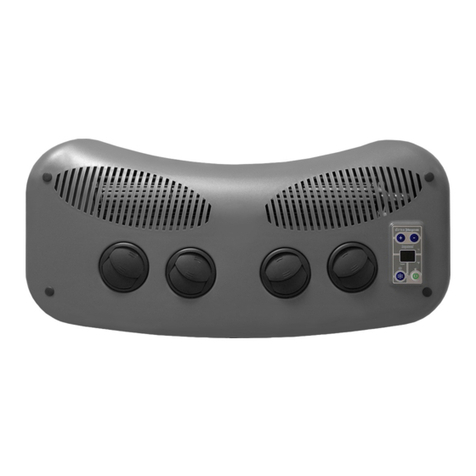
Bergstrom
Bergstrom Bycool Dinamic 1.1 User handbook

Mitsubishi Electric
Mitsubishi Electric MSZ-SF25VE operating instructions
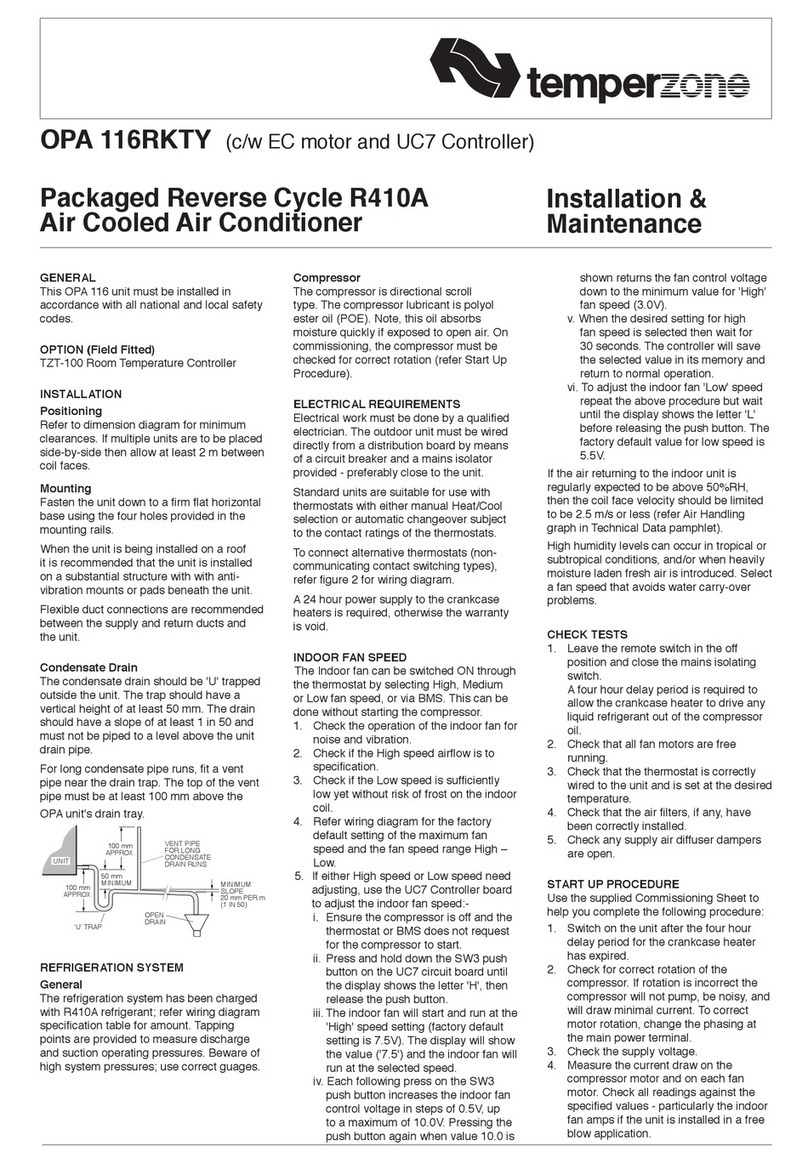
TemperZone
TemperZone 116RKTY Installation & maintenance
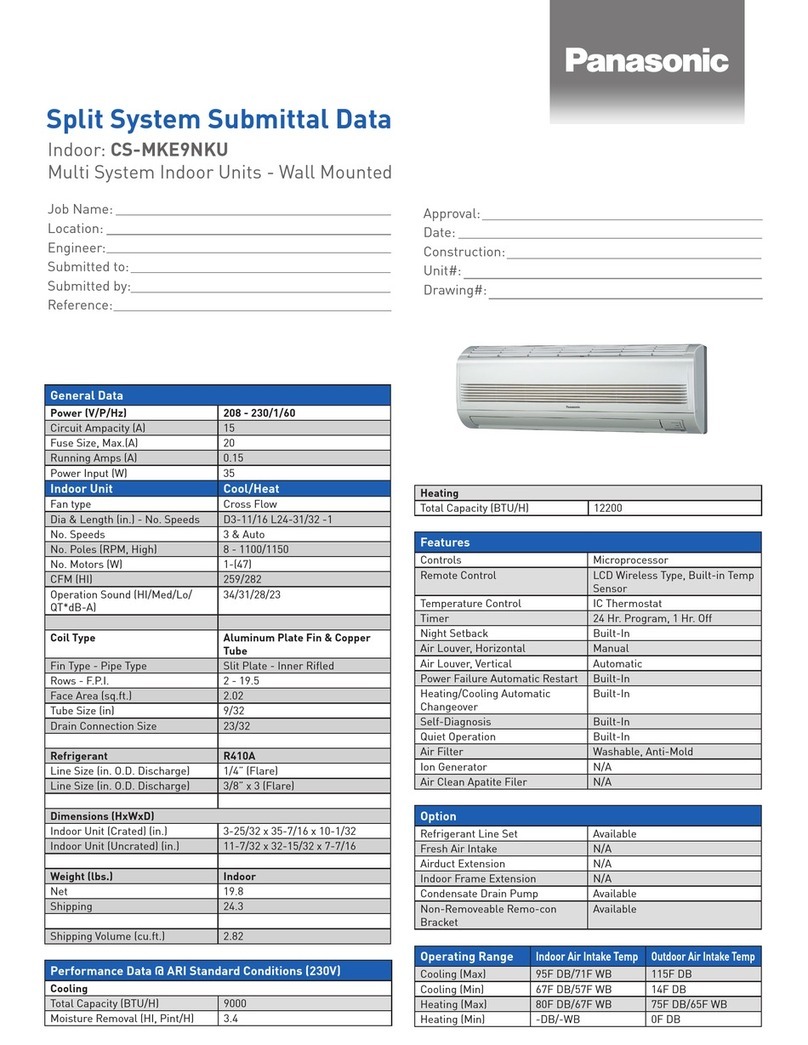
Panasonic
Panasonic CS-MKE9NKU Submittal data
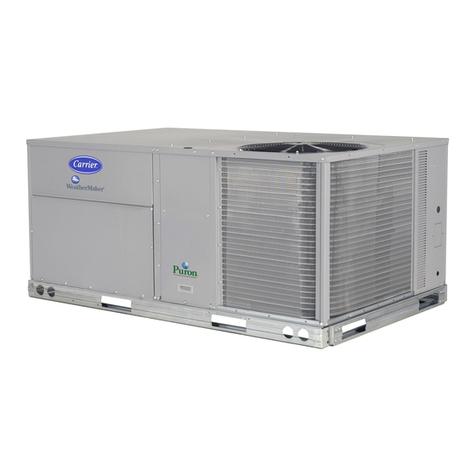
Carrier
Carrier 48TC series installation instructions
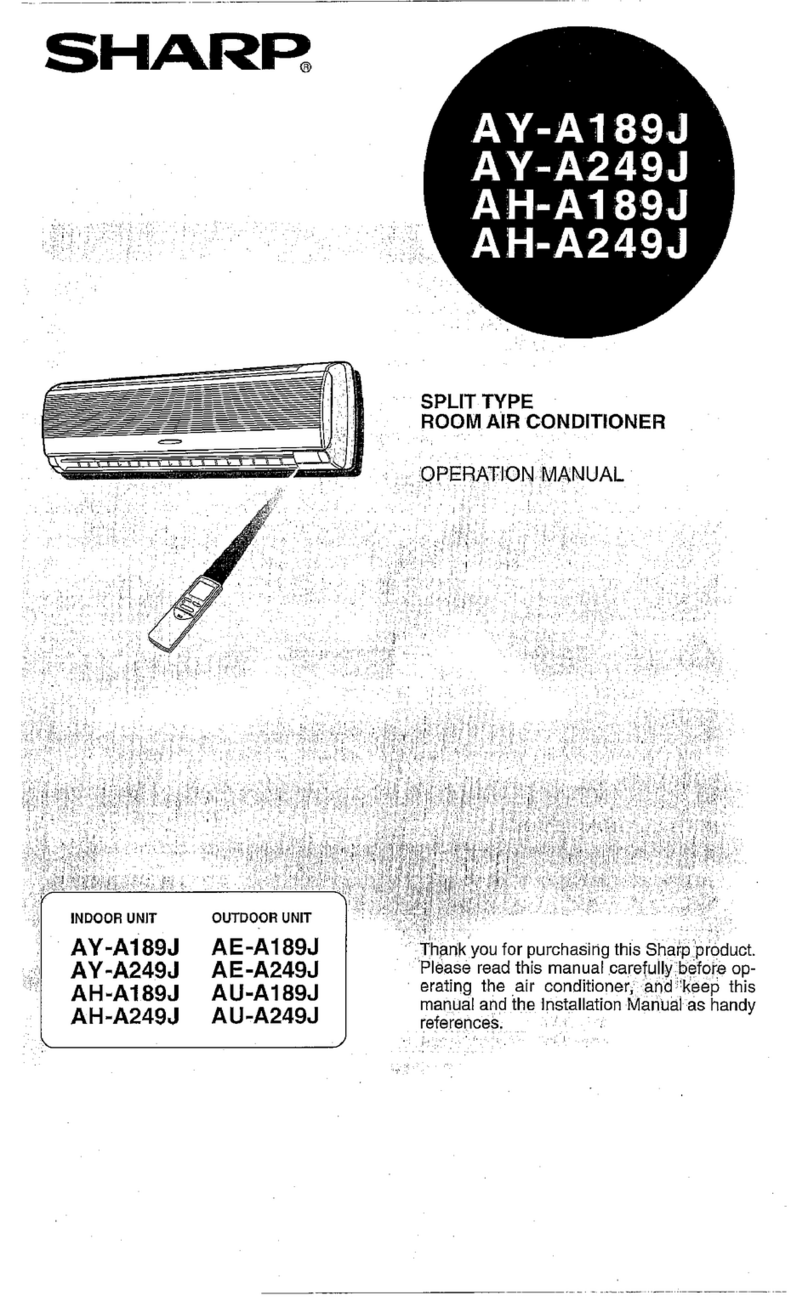
Sharp
Sharp AE-A189J Operation manual
